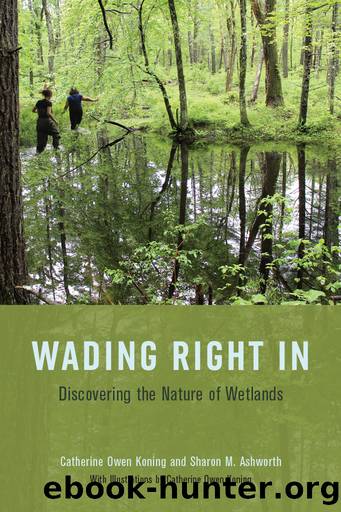Wading Right In by Catherine Owen Koning & Sharon M. Ashworth

Author:Catherine Owen Koning & Sharon M. Ashworth [Koning, Catherine Owen & Ashworth, Sharon M.]
Language: eng
Format: epub
Publisher: University of Chicago Press
Siren Song of the Bottomlands
A few states away from Jacquesâs bat study in Indiana, wetland ecologist Frank Nelson spends his days piecing together the ecological puzzles of the Mingo River basin in southeastern Missouri. The braided channel of the Mississippi River historically ran through this area, before changing pathways and leaving behind thousands of acres of wet bottomlands, which were kept watered by flow from the Castor River. In 1918, a diversion channel was built to shunt the water off these bottomlands thirty miles west, to the Mississippi River. Eventually, over six thousand miles of drainage ditches were built, drying out the lowlands for farming.
In the 1940s and â50s, some of the wettest areas became part of the Mingo National Wildlife Refuge and the Duck Creek Conservation Area. âMuch of the culture around here is all about huntingâ Frank explains. âSo the managers emphasized habitat for waterfowl.â They created wet basins containing open-water marsh, lakes, and forested swampland known as âgreen tree reservoirsâ in the Duck Creek Conservation Area, all of which are important habitat for pintails, teal, mallards, shovelers, and other ducks and geese. âBack fifty or sixty years ago, when these areas were developed, the engineers didnât think about how water flowed across the landscape; they just put some levees down, made it a rectangle, and they put the water-control structure in the lowest place. But the water just sits at the lowest spot and doesnât get the water off of the trees.â So the trees drown, and the creatures that depend on the forested wetlands lose their habitat. Part of Frankâs job has been to improve the water management so that a greater diversity of natural communities can survive. Using handheld GPS units and lots of swamp walking, Frank and his colleagues mapped out the detailed contours and curvatures of the land, trying to figure out where the water used to flow and how changes in water levels would affect the plants and animals.
Very small differences in elevationâless than a footâmake a big difference in the type of forest that grows in these lowlands. âBecause the rivers have shifted and moved over time, you have these small landforms, these little ridges; they may only be a foot or two, but the forest community has distinct changes along these ridges. There may be upland species like cherrybark oak [Quercus pagoda] and willow oaks [Quercus phellos], water hickories [Carya aquatica], even pawpaw [Asimina triloba] and hawthorn [Crataegus spp.].â
Walk a few inches downslope here (as well as in other southern sections of the midwestern and mid-Atlantic states) and the true wetland trees take over, such as the bald cypress (Taxodium distichum), a coniferous tree with rows of short needles and incredibly rot-resistant wood. Like the tamarack, this conifer sheds its needles every year, making it a deciduous conifer, which sounds a lot like an oxymoron but is not. Unlike pine and spruce, some cone-bearing trees drop their needles all at once. Thus the bald cypress is depilated each fall. Alongside the cypress, tupelo trees are a common companion.
Download
This site does not store any files on its server. We only index and link to content provided by other sites. Please contact the content providers to delete copyright contents if any and email us, we'll remove relevant links or contents immediately.
The Lonely City by Olivia Laing(4129)
Animal Frequency by Melissa Alvarez(3762)
All Creatures Great and Small by James Herriot(3527)
Walking by Henry David Thoreau(3238)
Exit West by Mohsin Hamid(3197)
Origin Story: A Big History of Everything by David Christian(3145)
COSMOS by Carl Sagan(2961)
How to Read Water: Clues and Patterns from Puddles to the Sea (Natural Navigation) by Tristan Gooley(2876)
Hedgerow by John Wright(2782)
The Inner Life of Animals by Peter Wohlleben(2776)
Origin Story by David Christian(2692)
How to Read Nature by Tristan Gooley(2669)
Project Animal Farm: An Accidental Journey into the Secret World of Farming and the Truth About Our Food by Sonia Faruqi(2668)
How to Do Nothing by Jenny Odell(2651)
Water by Ian Miller(2598)
A Forest Journey by John Perlin(2589)
The Plant Messiah by Carlos Magdalena(2458)
A Wilder Time by William E. Glassley(2367)
Forests: A Very Short Introduction by Jaboury Ghazoul(2337)
